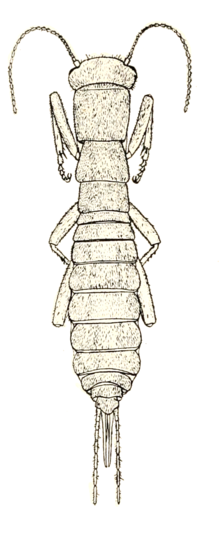Grylloblatta campodeiformis
| Grylloblatta campodeiformis | |
|---|---|
 |
|
| Scientific classification | |
| Kingdom: | Animalia |
| Phylum: | Arthropoda |
| Class: | Insecta |
| Order: | Notoptera |
| Family: | Grylloblattidae |
| Genus: | Grylloblatta |
| Species: | G. campodeiformis |
| Binomial name | |
|
Grylloblatta campodeiformis Walker, 1914 |
|
| External identifiers for Grylloblatta campodeiformis | |
|---|---|
| Encyclopedia of Life | 396197 |
| NCBI | 202358 |
| Also found in: | |
Grylloblatta campodeiformis, also known as the Northern Rock Crawler, is an omnivorous species of insect in family Grylloblattidae. Like other species in the genus Grylloblatta, it is endemic to North America.
This species was the first grylloblatid discovered and formally described in the scientific literature by Edmund Walker in 1914. It was originally placed in the order Orthoptera but has since been placed in the order Notoptera.
There are currently four subspecies:
Adults are typically 3 cm (1.2 in) long, excluding ovipositors and cerci, and are fairly elongate, wingless insects. They are a uniform honey-yellow in colour and covered with very short hair. Unlike some other species of grylloblatid, G. campodeiformis has eyes which have roughly 70 facets. The head is fairly flat and rounded. The thorax is elongate and over a third of the body length. The abdomen is composed of 10 segments and over half the body length. The legs are long and narrow (cursorial) with stout coxae and long femora. Their antennae are long ~9 mm (0.35 in) and thread-like. In adults the number of antennal subsegments is variable ranging from 24 to 27.
This species was originally discovered on Sulphur Mountain, Alberta in the Canadian Rockies at an altitude of 6500 feet. Subsequently it has been recorded from British Columbia (Canada), Montana, Washington (USA).
...
Wikipedia
